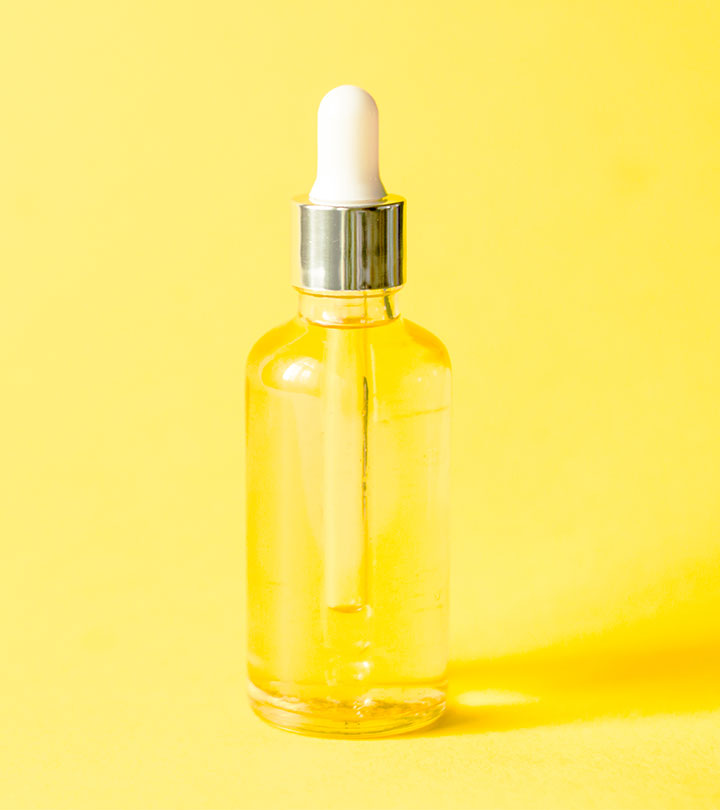For ages, willow bark extract has been used as an analgesic, antipyretic, and anti-inflammatory agent (1). Even now, many use willow bark extracts for skin-related issues and treat mobility disorders, such as arthritis or back pain.
Several benefits make willow bark extract an excellent ingredient to add to your skin care regimen. This article discusses how to use it for your skin, its benefits, application, and side effects. Scroll down to read more.
StyleCraze Trivia Willow bark is usually extracted from willow trees that are 2 to 3 years old.
In This Article
What Is Willow Bark Extract?
Shutterstock
Willow bark extract comes from a wide variety of willow trees, including white willow, black willow, and purple willow. The bark finds widespread applications and uses in medicine. It mirrors the effects of aspirin (due to its salicin content) to help treat pain and fever.
StyleCraze Trivia Willow trees are found worldwide except in Antarctica and Australia. They mostly grow in temperate and cold regions with moist soils.
Let us now explore the benefits of willow bark extract for your skin.
Benefits Of Willow Bark Extract For Your Skin
Shutterstock
The benefits of willow bark extract are attributed to its salicin, polyphenols, and flavonoids (1). That said, there is not enough evidence to support the benefits of using willow bark on skin. Hence, consult your dermatologist before using it to treat skin issues such as acne, inflammation, etc.
As per anecdotal evidence, willow bark extract may have the following benefits on your skin.
1. May Help Fight Acne
Willow bark extract may double up as a gentler, all-natural alternative to salicylic acid. It may help reduce skin oiliness and lower the chances of acne breakouts. This is one reason it is a regular ingredient in a host of skin toners.
Related: Facial Steam For Acne: Benefits And A Step-By-Step Guide
2. May Help Exfoliate Skin
Willow bark is extremely useful in gently exfoliating the skin and removing the dead skin cells. It may help make your skin become naturally radiant.
3. May Reduce The Signs Of Aging
This plant extract contains antioxidants like polyphenols and flavonoids that help fight against free radical damage and reduce the signs of aging. In fact, the salicin in white willow bark was found to demonstrate potent anti-inflammatory properties when taken orally (2).
It was found to improve the appearance of wrinkles, reduce tactile roughness, pore size, and boost overall skin radiance (2). It also helped improve pigmentation, firmness, and jaw-line contour.
4. May Reduce Redness And Inflammation
Willow bark can be used on sensitive skin with relative ease. It may calm the redness and irritation as it contains tannins, phenolic acids, and essential minerals. These nutrients are said to help minimize inflammation and help boost the cell regeneration process.
Related: Skin Inflammation: Causes, Symptoms, Diagnosis, And Treatment
5. May Help Shrink Large Pores
The tannins in willow bark are thought to act as a natural astringent. They may help reduce the appearance of large pores and keep the skin tight at the same time.
6. May Treat Dry Skin
The antioxidants in willow bark may help skin retain moisture. Regular use of willow bark is thought to help treat dry skin conditions like eczema and psoriasis.
If used right, willow bark may pave the way for glowing and youthful skin. In the next section, we will look at how you can use willow bark to for its potential skin benefits.
Related: 10 Remedies To Heal Dry Skin Around The Nose & Prevention Tips
How To Use Willow Bark Extract For Skin
1. Pair It With A Good Moisturizer
The powerful exfoliating properties of willow bark extract may have a drying effect on your skin. Hence, always follow up with a hydrating moisturizer.
2. Use It With Salicylic Acid
Use willow bark with products containing salicylic acid to boost the overall exfoliating and skin-cleansing benefits.
Some suggest against using willow bark with retinol.
Willow bark is often included as an active ingredient in cleansers, moisturizers, and toners. Using it with retinol is believed to cause certain adverse effects.
Willow bark is also not often recommended to be used with vitamin C. Information in this regard is scarce.
StyleCraze Trivia Willow bark extract must be stored in an airtight and sealed jar or a dry paper bag to maintain its effectiveness.
Willow bark may cause some adverse effects. It is important to be aware about them before you start using the extract.
Side Effects Of Willow Bark Extract For Skin
Shutterstock
Willow bark extract is relatively safe and can be used daily. However, keep the following pointers in mind.
- Willow bark may cause allergic reactions and skin irritation, especially for those allergic to salicylates (3). Hence, do a patch test before you use it topically.
- Consuming excess willow bark may cause stomach cramping and bleeding. However, more research is warranted in this regard.
- Those allergic to aspirin may have a reaction to willow bark (4). Anecdotal evidence reports cases of itching, redness, and rashes. Those with asthma, diabetes, gout, hemophiliai XA rare, genetic bleeding disorder that impairs the body’s ability to make blood clots needed to stop bleeding. , hypoprothrombinemiai XA condition characterized by prolonged bleeding due to the deficiency of prothrombin, a blood-clotting substance. , and liver disease might be sensitive to aspirin, and must avoid willow bark.
- Avoid using this plant extract with medications like blood thinners and beta-blockersi XA group of medications that block the effects of epinephrine to slow down the heartbeat and reduce blood pressure. .
- Children, adolescents, and pregnant and lactating women must avoid using willow bark in any form (5). It is thought to cause Reye’s syndrome, a condition that leads to brain and liver damage.
- Avoid using willow bark if you have a kidney disorder. It is thought to reduce blood flow to the kidneys and lead to renal failure.
- Stop consuming willow bark two weeks before and after any scheduled surgery. It is believed to cause bleeding.
Many of these side effects are yet to be validated by research. Consult your doctor for more information.
Willow bark is often compared with salicylic acid. Which of the two is better? Let us understand more in the next section.
Willow Bark Extract Vs. Salicylic Acid: A Comparison
iStock
Willow bark extract doubles as an effective natural source of salicin and works similarly to salicylic acid. In fact, willow trees contain salicin. Salicylates, including salicin and salicylic acid, are found in the bark and leaves of the willow trees (6).
Willow bark contains not less than 1.5% of total salicylic alcohol derivatives, making it a gentler alternative to salicylic acid (7).
The salicin in willow bark extract is responsible for its potent antibacterial, antioxidative, and anti-inflammatory properties. However, the extent of willow bark extract’s effectiveness on skin issues as compared to salicylic acid has not been conclusively proven yet.
Salicylic acid, on the other hand, has been in use to treat various skin disorders for more than 2,000 years (6). It can exfoliate the skin and may be a good agent for peeling, especially in patients with acne, melasmai XA common skin disorder that causes patches and spots darker than the natural skin tone of the face or neck. , photodamage, and freckles.
But salicylic acid is a more aggressive compound, especially for people with sensitive skin. It may cause redness, irritation, and acne breakouts.
Willow bark extract is a much gentler form of salicylic acid and may safely be used on sensitive and acne-prone skin.
Infographic: Willow Bark Toner Recipe
Willow bark has several skin benefits. You can use it as a moisturizer, cleanser, or exfoliator. Applying willow bark extract on the skin may help soothe several skin issues, including acne. The DIY recipe discussed below will help you prepare a willow bark toner for your acne issues. Check out the infographic below to know more!
Willow bark has been popular for its pain-relieving properties and is widely used to treat pain and fever. However, you can also use willow bark extract for skin care troubles like premature aging and acne breakouts. The benefits of willow bark extract include fighting acne, exfoliating, improving pigmentation, reducing inflammation, and treating dry skin. It is considered safe for daily use. However, you may experience allergic reactions if you are allergic to salicylates. Therefore, always perform a patch test before incorporating it into your skin care routine.





